Speak directly to the analyst to clarify any post sales queries you may have.
KEY HIGHLIGHTS
- The computing power in data centers in Latin America is growing due to an increase in the demand for cloud services, big data, and IoT, which has led to an increase in rack power density. The increase in data bandwidth and high-performance computing will drive operators to procure generator sets to manage any downtime in data centers.
- The adoption of diesel generator sets is high in Latin America, with major data center operators adopting these generator sets. For instance, Equinix has adopted two diesel generator sets of N+1 redundancy and a power capacity of 1.9 MW at its MX2 data center
- DRUPS systems have gained traction in the market and are being adopted by operators such as Ascenty (Digital Realty), which has adopted a DRUPS system at its Rio De Janeiro data center facility.
- The Latin American data center generator market is also expected to witness the adoption of innovative technologies in the forecast period, including hydrotreated vegetable oil (HVO fuel) based, gas-powered, and fuel cell generators.
SEGMENTATION ANALYSIS
- In 2021, investments in the region in terms of system capacity were highest in 1.5-3 MW generators, followed by those with a capacity up to 1.5 MW.
- The growth in the development of larger data center facilities and expected growth in cloud service provider investments in the region will raise investments in generators of a capacity over 3 MW. Also, the growth in the deployment of modular data centers will aid investments in generators with a capacity of around 1 MW.
- In 2021, Brazil led the investments in the procurement of data center generators, followed by other Latin American countries such as Colombia, Argentina, Peru, and others.
Segmentation by System Capacity
- 0-1.5 MW
- 5-3 MW
- >3 MW
Segmentation by System Type
- DRUPS
- Diesel & Gas & Bi-Fuel Generators
Segmentation by Tier Standards
- Tier I & II
- Tier III
- Tier IV
Segmentation by Country
- Latin America
- Brazil
- Mexico
- Chile
- Other Latin American Countries
KEY TRENDS
Focus on Automation and Remote Monitoring of Infrastructure is Gaining Traction
Data center operators in Latin America are focusing on the adoption of solutions such as automation and remote monitoring of power infrastructure, including generators, which will help in reducing OPEX by monitoring the generator performance. This will also help in assigning the required number of installations to meet the power demand and thus help in reducing wastage of energy and fuel
Adoption of Innovative Solutions will Change the Market Dynamics
- Some new innovations in the data center generator market include fuel cells, natural gas, hydrogen fuel, and bi-fuel. Ethanol fuel can also be expected to be used in data centers in the market.
- Vendors in the market have started innovating product offerings to match market requirements, along with some operators testing new innovations in their data centers.
VENDOR ANALYSIS
The growing data center investments by local and global operators are also attracting major providers to invest in the market. The market has the presence of several global vendors such as ABB, Cummins, Eaton, Generac Power Systems, Kohler, Mitsubishi Electric, Rolls Royce, and others.
Several vendors are launching new offerings to cater to the market demands. For instance, Mitsubishi Electric launched its MGS-R Series generator sets for commercial deployments, which include the data center market.
Prominent Vendors
- ABB
- Aggreko
- Bruno
- Caterpillar
- Cummins
- Detroit Diesel
- Eaton
- Generac Power Systems
- Kohler
- Mitsubishi Electric
- Rolls Royce
- YANMAR HOLDINGS
KEY QUESTIONS ANSWERED
1. How big is the Latin America Data Center Generator market?
2. What is the growth rate of the Latin America Data Center Generator market?
3. Who are the key players in the Latin America Data Center Generator market?
4. What are the growth factors in the Latin America Data Center Generator market?
5. Which country holds the largest share in the Latin America Data Center Generator market?
Table of Contents
Companies Mentioned
- ABB
- Aggreko
- Bruno
- Caterpillar
- Cummins
- Detroit Diesel
- Eaton
- Generac Power Systems
- Kohler
- Mitsubishi Electric
- Rolls Royce
- YANMAR HOLDINGS
Methodology
Our research comprises a mix of primary and secondary research. The secondary research sources that are typically referred to include, but are not limited to, company websites, annual reports, financial reports, company pipeline charts, broker reports, investor presentations and SEC filings, journals and conferences, internal proprietary databases, news articles, press releases, and webcasts specific to the companies operating in any given market.
Primary research involves email interactions with the industry participants across major geographies. The participants who typically take part in such a process include, but are not limited to, CEOs, VPs, business development managers, market intelligence managers, and national sales managers. We primarily rely on internal research work and internal databases that we have populated over the years. We cross-verify our secondary research findings with the primary respondents participating in the study.

LOADING...








